This past Halloween Day I witnessed a macabre and bloody scene on the icy shores of Hudson Bay- two male polar bears consuming a bearded seal. It was one of my all-time highlights of 11 years guiding Polar Bear trips for Natural Habitat. Each season the bears in the Churchill Wildlife Management Area get a few seals during the one month window where they concentrate on the shore waiting for the ice to form, but it is a rare occurrence. We came upon two young males who had recently killed a seal on Gordon Point, and to my surprise, they seemed to share the meat without conflict. Polar bears are very social animals, and commonly tolerate sharing meals when there is plenty to eat, much like brown bears on whale carcasses, but by October these bears have had little to eat since the ice melted last summer. I expected the bears to be fighting for every calorie, but just when you think you have bears figured out, they throw you for a loop.
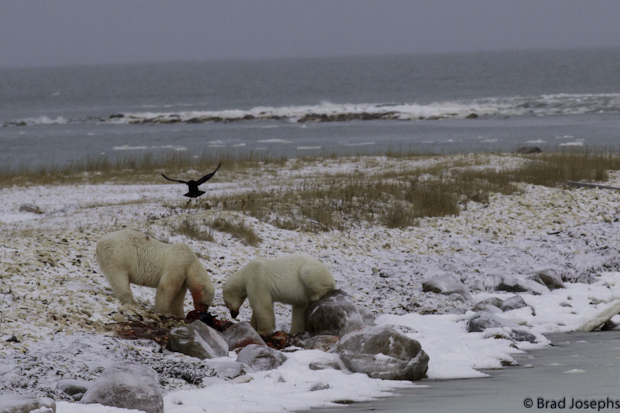
Two male polar bears share a bearded seal carcass on Gordon Point near Churchill.
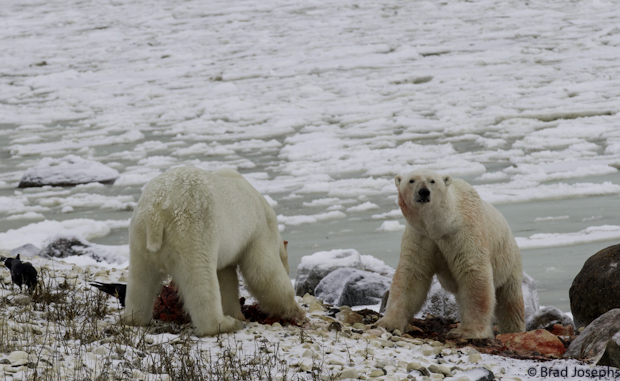
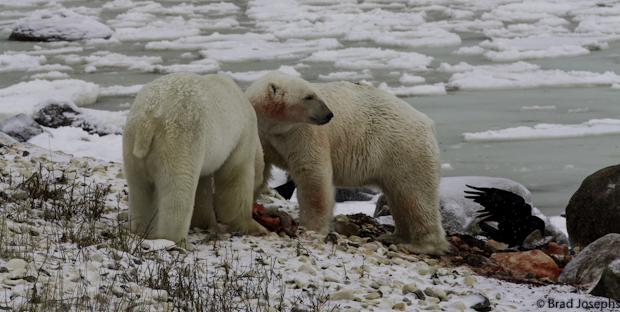
The bears weren’t only tolerant of each other, they seemed indifferent to a pair of hungry ravens. Folks who have traveled with me in the past are well aware that I am huge admirer of ravens. Their superior intelligence levels, role in natural history lore, and connection to large predators such as bears and wolves has fascinated me for decades (click here to read one of my past articles on ravens). Normally ravens are notoriously difficult to photograph as they are so observant and seem to dislike camera lenses pointing at them (maybe reminds them of firearms?). Two ravens fed on the carcass among the bears, and the lure of the rich meat and fat distracted them enough for my group and I to get some cool shots.
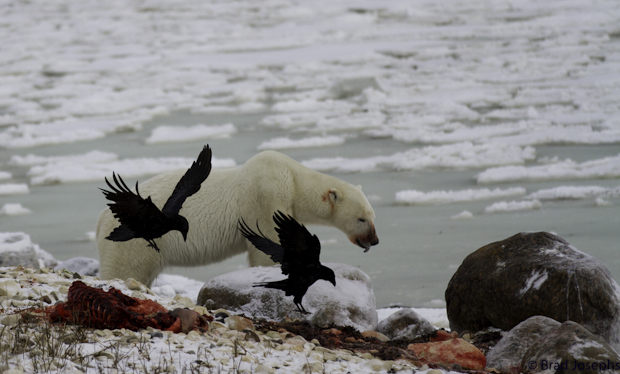
Two ravens land on the carcass as the bear in the background takes a break to wash down the seal blubber with some seawater.
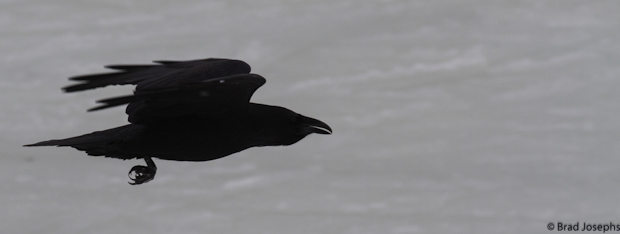
Ravens, like all corvids, don’t simply eat until they are full and take a rest. They will take as much meat as they can, and stash it in hiding places for later. Their well-developed brains allow them to remember possibly hundreds of food cache locations. Having food put away for later enables ravens to survive the harsh arctic winters. Notice the lump in the raven’s throat- this is seal meat in its crop destined for storage somewhere on the tundra.
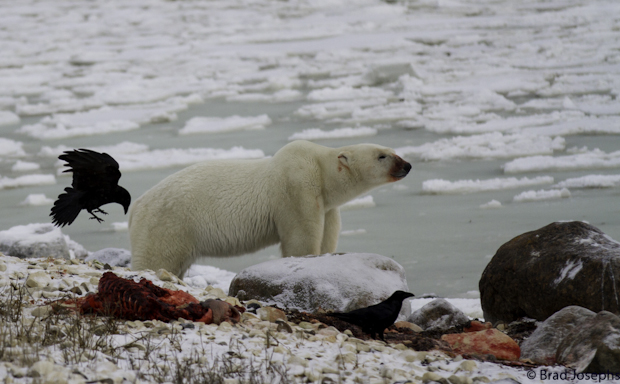
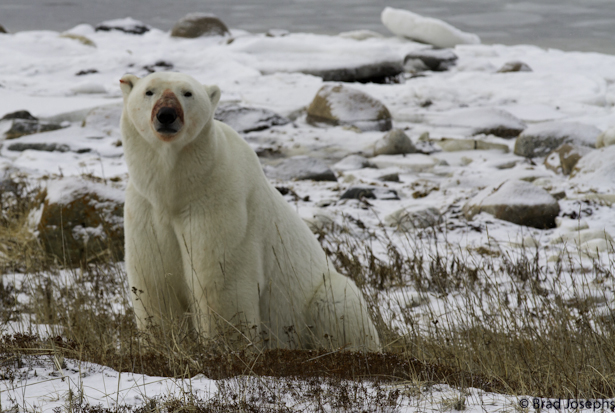
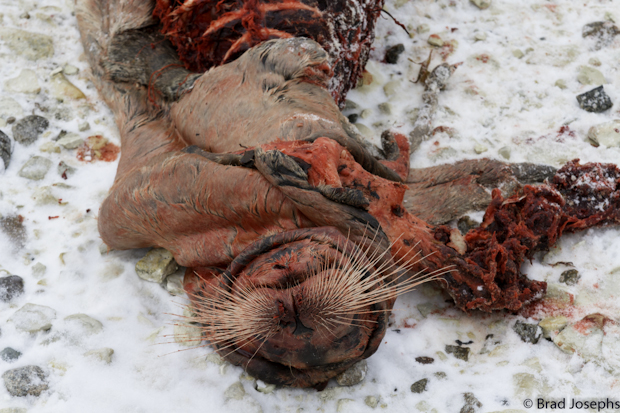
While the bears took a nap, we moved in for a brief, closer look. We could tell the carcass is of a bearded seal because of the very long whiskers. These whiskers, for which the seal gets its name, are much longer than those of ringed seals, the smaller and more numerous seal of the region which makes up the majority of the polar bear’s diet in Hudson Bay.
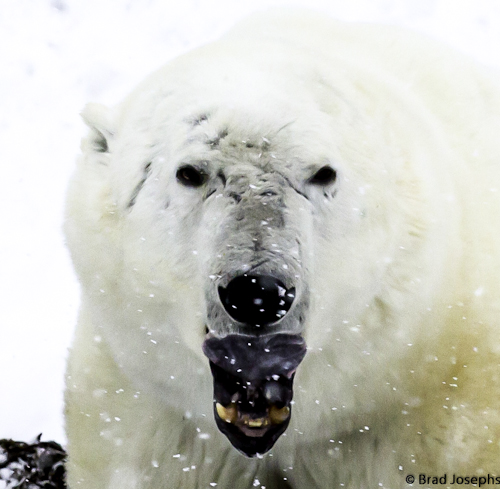
We saw this huge, scarred-up male near the seal kill a week later. This spot attracted more bears than usual for quite a while after the meat was gone.
It was remarkable to see these bears, and ravens, get a bonus meal during this period when seals are so elusive. As the ice extends into the sea the bears head far offshore, making these kills impossible to witness. Bears must catch an average of one seal per week to sustain themselves. However during March through June they will devour much more than that, giving them the ability to build up their fat reserves to carry them through ice-free periods. As the climate warms, and the presence of ice shortens the polar bears lose hunting time. If our climate continues to warm at the current rate, it is widely thought that polar bears will be extinct in the wild by 2050. Click here to read more about the latest thoughts on polar bears and climate change. Once you have seen these magnificent animals in real life, this thought is simply unbearable.
Want to read more about Churchill and polar bears? Click here to check out this awesome blog dedicated to everything Churchill.

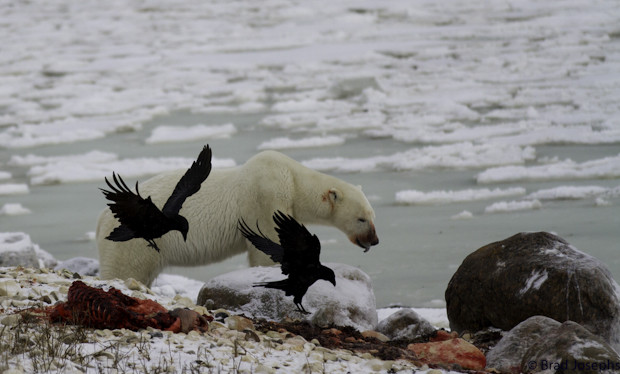

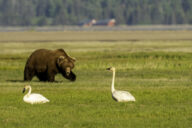

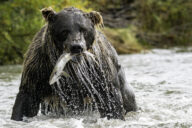
2 Comments
Fantastic Images — over a period of time that the bears nd ravens (who must have known you were there) let you photograph their eating. As to “Climate Change” the period around 1000AD that allowed farming of Greenland was as warm of warmer than that projected and I believe polar bears survived that so — in this new environment, they’ll likely survive again.
NOTE: This comment from one who is — for many other reasons — happy to advocate genocide of 5-billion of the current 7-billion humans !!
Hi Brad,
Looking back over this sequence of photos, I realized that there was a back story that you all missed. First of all, it looks to me that they are mother and cub. Either that or possibly siblings. What’s driving the whole thing is the female’s need to provide for herself and her “child”. She’s doing a splendid job and is protecting them both vigilantly. In the one photo, she even seems ready to position herself between the cub and some danger she’s spotted on the right.
I love the big male with his fangs and all those scars. Reminds me of old photos I have of Goliath. Remember him?